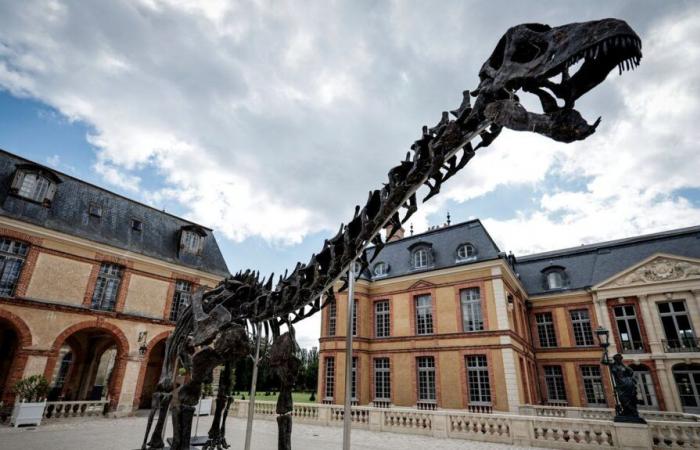
Vulcain took up its summer quarters at the beginning of July in Dampierre-en-Yvelines, southwest of Paris, while awaiting its auction on Saturday November 16. It is the largest dinosaur skeleton ever offered for sale. The imposing specimen is more than 20 meters long and made up of 80% of the original bones, from the head to the long tail. And “that's very rareunderlines Saturday on franceinfo the former president of the Natural History Museum of Paris, Bruno David, because often after death, the bones are scattered”.
Moreover, “it’s very interesting scientifically because it allows us to reconstruct the life and death itinerary of this individual”adds the naturalist, specialized in paleontology and the sciences of evolution and biodiversity. About 150 million years ago, this herbivorous giant, a “Apatosaurus, formerly called Brontosaurus”he specifies, explored a much less sophisticated setting than this 17th century castle and frequented vast wetlands. This quadruped with a long neck roamed what is today the American West in search of vegetation to devour, long before Steven Spielberg made it one of the emblems of his film Jurassic Park.
“Several species of these brontosaurs probably lived on these Wyoming plains and this may be news”says Bruno David. But to find out, “we need a precise analysis of its skeleton, its bones, to see the differences with known species to know if it is something that is added to what we know or not. This is of major scientific interest “. Through this analysis, “we can know if he was sick, if he had osteoarthritis, if he had been attacked by an allosaurus, a large carnivore from the same era, what he experienced. And then we are able with investigations to know what environmental message it brings us through the chemical or geochemical analysis of its bones. This allows us to have an open window on this era.
Three years of excavations have been carried out since 2018 by a European team in Wyoming, before the complex was restored in the south of France, to be presented to the public and finally sold to the highest bidder. Vulcain is estimated at between 4 and 5 million euros, but you will undoubtedly have to pay much more to acquire it. Because the market figures are completely crazy: 44.6 million dollars for a stegosaurus sold this summer, 32 million for a tyrannosaurus sold in 2020. Impossible for a museum to afford it, “in any case, for the National Museum of Natural History”, deplores Bruno David.
“You have to go through patrons. If the patron in question acquires the dinosaur and entrusts it to a museum, that's great. If it's to put it in his living room, it's much less interesting. Carnegie, at the late 19th-early 20th century, had acquired a diplodocus. He put it in the Pittsburgh museum and made a series of casts which he entrusted to the European Museum, including one which is also in Paris.. But several specimens have disappeared from circulation, regrets the naturalist, who would like “protection as for archaeological remains”.
The sales contract, however, stipulates that the future owner must give access to paleontologists to study this skeleton. “There are still limits to exercisepoints out Bruno David, who doubts that the owner will accept that scientists borrow a bone or let them do research. “small holes in the bones to collect a little dust”.





